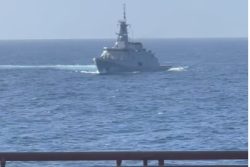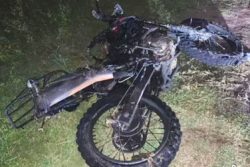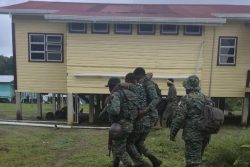The Guyana Defence Force (GDF) remains in possession of some twenty-six dredges seized last month during a raid in the Kaieteur National Park (KNP) and there is complete silence from it, the Ministry of Natural Resources and the Protected Areas Commission (PAC) on what happens next.
Aside from concerns over the enforcement role played by the GDF in this operation and its continued holding of the equipment, as opposed to handing it over to the police or the PAC, observers note that there are other critical questions for the authorities to answer. The observers say it is now up to the authorities to demonstrate, particularly to the residents of Chenapau, that the equipment was indeed confiscated within the boundaries of the KNP. Further-more, the authorities should be tracking down the owners of the equipment even though a decision was taken not to prosecute a number of Chenapau residents who were accused of mining illegally in the KNP and brought to the city.
President David Granger had ordered the covert operation, named Operation Midas, which was carried out jointly with the Guyana Geology and Mines Commission (GGMC), the PAC, the GDF and the police.
The operation followed concerns by the President that an aerial view of the Kaieteur National Park area showed about 15 illegal operations, Minister of Natural Resources, Raphael Trotman had explained to Stabroek News.
“This was brought to the attention of the President, who for all intents and purposes, as the Minister of Environment, asked the Protected Areas Commission … that swift action be taken against it, hence it was done.”
Trotman had noted that the Kaieteur National Park is a protected area and as such mining is strictly prohibited there. “The falls are the number one symbol of strength of environment and bio diversity and the image of mining around the park is inconsistent with us maintaining that strong symbol and image,” he said.
During the operation, 21 residents of Chenapau Village, Region Eight were arrested on allegations of having participated in illegal mining within the KNP.
This resulted in them being flown to Georgetown where they were charged and issued with summonses to attend court in Mahdia to answer the charges. Shortly after this however, the government announced that as an “act of goodwill” the charges against the residents would be dropped.
Nonetheless, those previously arrested, along with the Chenapau Village Council have vehemently denied mining in the KNP, adding that though they do engage in subsistence mining, their camps are located way out of the KNP boundary.
The army later informed that 26 dredges were seized.
“The recent Joint Services Exercise, Operation Midas, revealed the extent of the environmental degradation plaguing the Park due to widespread illegal mining activities occurring within the boundaries of the protected area of the Park. The operation unearthed some 26 engines (dredges) among other pieces of mining equipment and environmental pollutants such as Mercury, Waste Oil and Silicone, which were being used indiscriminately by the illegal miners,” the army said in a press statement.
Both the Ministry of Natural Resources and the army have since stated that they could not say what had happened to the 26 dredges seized.
When this newspaper contacted MNR, its Public Relations Officer Johann Earle asked that all questioned be emailed. The emails were not answered and when he was called to find out the reason for the delay he said that as much as it was a joint operation, the KNP does not fall under that ministry’s jurisdiction so they would not be in a position to give any comment.
He directed the reporter to the head of the Protected Areas Commission, Denise Fraser.
The Guyana Defence Force’s Public Relations personnel also said that all questions regarding the operations should be directed to the PAC.
Countless emails, calls and visits to Fraser were to no avail. Whenever the reporter visited Fraser’s office the response is “She’s in a meeting” or “She is preparing to go to a meeting”.
To add to the number of futile attempts to learn about the fate of the dredges, Commissioner of the GGMC, Newell Dennison said he had “no comment” when contacted yesterday.
But sources close to the operation told this newspaper that the army has the 26 dredges it seized and is awaiting instructions on what to do.
This newspaper understands that most of the dredges are not high-powered or very expensive engines with a great percentage being “not a real dredge in that sense but water pumps used with two-inch hoses.”
“They are not used on large scale operations … You have a water pump…and you take two-inch hoses and lead them to a wooden sluice box…that kind of operation. There is no marrack or jetting engines…it is a small-scale operation,” one source explained.
They are not big in size either and can easily be lifted by one or two persons, depending on size, and concealed in bushes if quick action to hide them is necessary, such as in a raid.
One source believes that because the miners are cognisant that the areas are illegal zones and raids are imminent they do not invest in branded and expensive equipment.









